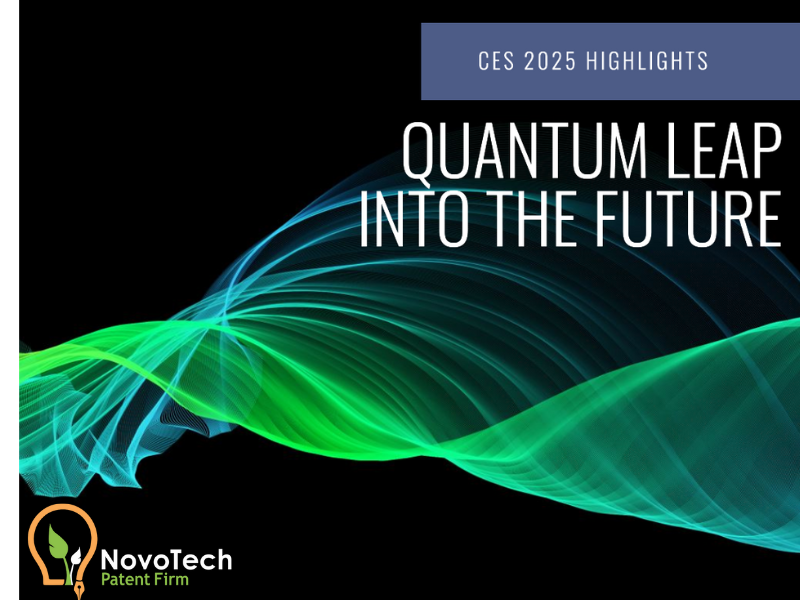
CES 2025 Highlights Quantum Technology Innovations
By Babak Akhlaghi on January 17, 2025. CES 2025 gathered over 141,000 attendees, including leading industry figures, innovators, and media representatives, along with 4,500 exhibitors showcasing the future of technology. I attended to explore trends and innovations, emphasizing the need to understand technology’s evolution to safeguard clients’ innovations. The event provided invaluable insights into cutting-edge advancements across various sectors, with quantum technology highlighted as a transformative force in technology.
Technological Highlights
This year’s CES highlighted human creativity and the rapid advancement of technology, pushing boundaries across various industries.
Quantum Technology
Quantum technology was a major focus at CES 2025, marking a transformative shift in innovation. Industry leaders predict utility-scale quantum computers by 2028, with breakthroughs already revolutionizing fields like cryptography and renewable energy. With global investments soaring and economic impacts expected to reach trillions, the potential of this technology is undeniable—details below.
Automotive Innovations
Automotive technology took a major leap forward with advancements like a brainwave-reading system capable of suggesting actions and controlling vehicles based on the driver’s mood. The holographic windshield display was another highlight, exemplifying the focus on futuristic, user-centric driving experiences.
Robotics and Smart Home Appliances
Robotics and home appliances poised to make daily life more efficient captured attendees’ attention. These devices emphasized comfort, automation, and practicality for real-world use.
Zero-Emission Jets
The aviation industry introduced a revolutionary single-blended wing aircraft design, marking a definitive step toward sustainability. This design cuts emissions by 50% and enhances efficiency while harnessing AI to provide pilots and manufacturers with advanced feedback systems.
AI Glasses
Smart glasses redefined convenience with features like real-time navigation, QR code scanning, instant discount notifications, and captions for every conversation. These devices showcased how accessibility and personalization continue to evolve in technology.
Smart Devices
Innovations ranged from self-watering potted plants to health-monitoring dog collars capable of detecting diseases early, offering solutions that blend convenience and care in daily life.
Advanced GPUs
Advanced GPUs unveiled at CES have the potential to revolutionize entertainment and productivity, enabling high-definition movie production from personal computers supported by artificial intelligence.
Supercomputers with AI Chips
For tech enthusiasts and professionals, CES introduced on-device supercomputers with AI chips, now available at consumer-friendly prices. These machines bring the power of advanced AI into homes while eliminating the need for cloud-based systems for processing large language models.
Quantum Computing Takes the Spotlight
If artificial intelligence stole the show last year, CES 2025 marked the rise of quantum computing as the next frontier in innovation. I believe that quantum computing will completely reshape the industry, revolutionizing how businesses operate and how consumers interact with technology. While some argued that the technology is decades away, industry leaders at CES disagreed, asserting that it is already here, with utility-scale quantum computers expected to be operational by 2028. They shared pivotal insights into quantum technology’s timeline, applications, and far-reaching impact, emphasizing its crucial role in shaping the future.
Economic Promise and Disruption Potential
Industry experts estimate quantum technology could generate an economic impact of $1 to $2 trillion by 2025, driving advancements that mirror the Internet revolution of the late 1990s and early 2000s.
Key Market Segments
Key focus areas of quantum technology include:
- Quantum Computing to enable problem-solving at the subatomic level
- Materials Science for the creation of novel materials with unique characteristics
- Sensing technology adopted in fields like bioimaging, environmental monitoring, and infrastructure assessment
- Cryptography to enhance data protection and develop quantum-specific security solutions
- Quantum Communications to revolutionize connectivity with quantum principles
Global Investment and Industry Collaboration
Global investments in quantum technology are surging, with countries such as the US allocating $4 billion and others committing even larger sums. Forums like the Quantum World Congress, held annually since 2022, continue to catalyze collaboration among scientists, technologists, and policymakers.
Practical Applications and Milestones
Quantum computing is already transforming sectors like autonomous driving and renewable energy. One notable milestone is the planned launch of a quantum communications satellite in 2026, signifying its progression into real-world applications. Utility-scale quantum computers are expected to be operational by 2028, with rapid developments in error correction and algorithms shortening previous timelines.
Looking Ahead to the Quantum Future
It looks like the next 12 to 24 months are set to bring exciting progress, including broader adoption of quantum algorithms, advancements in the quantum Internet, and refinements in machine reliability. Whether applied to computational biology or vaccine development, quantum technologies are expected to unlock solutions to challenges once thought insurmountable.
Key Takeaways
- Quantum is here and now and is set to drive substantial change and economic impact.
- The quantum market is diverse, with significant advancements in computing, materials, sensing, cryptography, and communications.
- Global investments and talent development are accelerating the progress of quantum technology.
- The Quantum World Congress is fostering collaboration and knowledge sharing among global leaders.
- Leading companies are making significant investments and achieving milestones in quantum technology.
- Quantum computing is expected to achieve utility-scale capabilities within the next few years.
- Quantum and classical computing will coexist, driving advancements and innovation in various industries.
Stay Informed with Expert Insights!
Want more valuable tips on navigating patent law and protecting your intellectual property? Join our free weekly newsletter for the latest updates, expert advice, and exclusive content straight to your inbox. Subscribe today and never miss out on essential information that can make all the difference in your patent journey! Subscribe to our Newsletter